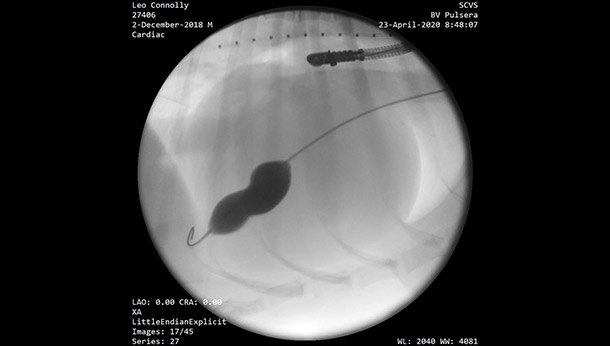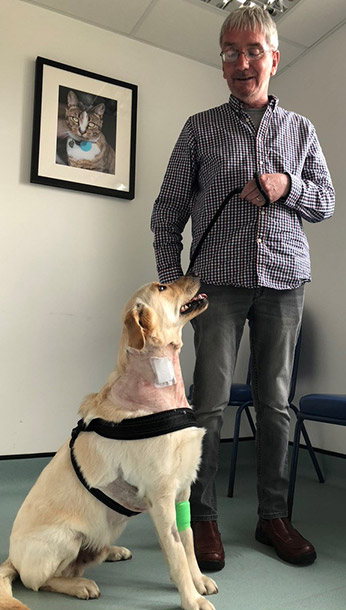Leo’s owners had become concerned because Leo’s abdomen had become swollen. After seeing their regular vet, who was concerned Leo might have heart disease, Leo was referred to see Tom Mullany, a veterinary cardiologist in Dublin. Tom discovered that Leo had Tricuspid Valve Stenosis, which was causing the fluid distension of his abdomen. Tricuspid Stenosis is a congenital heart abnormality of the inflow valve on the right side of the heart (the tricuspid valve), causing narrowing (stenosis) of the valve, resulting in congestive heart failure.
Leo was in heart failure and his owners were very anxious to get cardiac surgery performed before his condition deteriorated. The COVID-19 lockdown made it very difficult for them to find a specialist centre who were prepared to treat Leo’s rare condition. Tom Mullany got in touch with the team at SCVS and after reviewing the ultrasound study of Leo’s heart, SCVS agreed to take Leo on as a patient.
Leo’s owner had an online video consultation with Tobi Wagner to discuss treatment options for Leo. Thankfully Leo was a suitable candidate for keyhole intervention, so all that remained to do was to get Leo all the way over from Dublin to SCVS in Hampshire.
Tobi, who treated Leo, said; “Although this disease cannot be cured, a procedure called Balloon Valvuloplasty can be performed to alleviate symptoms. Balloon valvuloplasty involves placing a balloon across the narrowed valve, which is then inflated to stretch the valve open. This is a “keyhole” procedure, performed via a tiny puncture in the Jugular vein.”
Tricuspid stenosis is rare, whereas narrowing of the pulmonic valve (Pulmonic Stenosis) is much more common. Balloon valvuloplasty for pulmonic stenosis a routine procedure for specialist veterinary cardiologists, whereas balloon dilation of the tricuspid valve is uncommonly performed. The tricuspid valve requires very careful handling and a lot of interventional experience as ‘overdilation’ can result in a very leaky valve, potentially making the condition worse rather than better.’
Balloon valvuloplasty is quite an expensive procedure, and Leo’s owners discovered that their pet insurance company would not cover treatment performed outside of Ireland. Undeterred, they set up a crowd fund and managed to raise enough funds for Leo’s lifesaving surgery in a very short period of time so that the surgery could go ahead.
Tobi continued, “After a long car journey from Dublin to Southampton, Leo arrived with us at SCVS on 22 April. He had further cardiac ultrasound that day, which showed fluid accumulating around Leo’s heart as well in his abdomen, so the surgery was becoming really urgent. Stephen Collins and I performed the balloon valvuloplasty the following day, with one of our Specialist anaesthetists, Derek Flaherty, ensuring Leo’s safety during the anaesthetic.”

“Leo made a great recovery. Fluid accumulation around the heart, which was related to the heart failure, resolved within 24h after the intervention. Good reduction of pressure gradients across the narrowed valve were achieved (measured during the op, before and after “ballooning”) and the rapid disappearance of fluid congestion following the operation indicated the procedure was a great success.”
Leo went home the following day. Leo and his owners are very happy with the outcome. The entire team at SCVS were very pleased to be able to help Leo during these difficult times and wish him all the best for his future.
